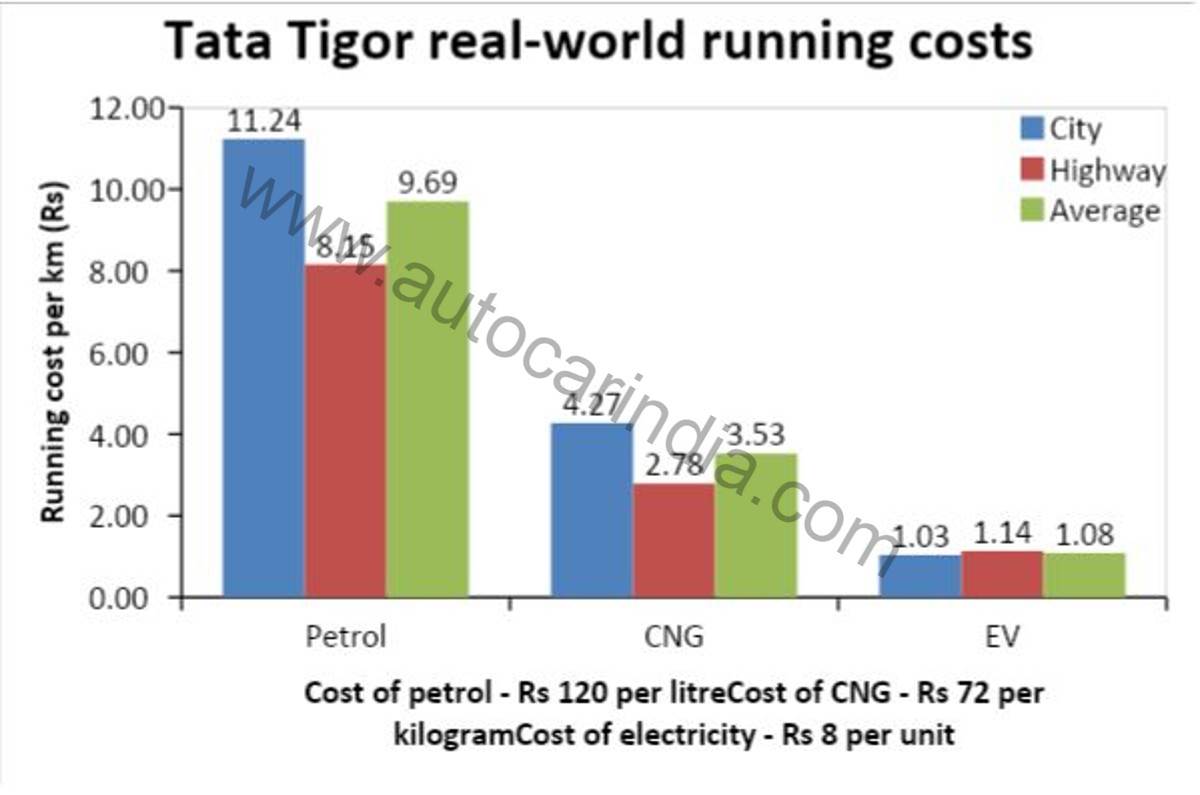
After the introduction of an all-electric version, alongside the petrol, Tata Motors has extended the Tigor's variant range with the launch of the Tigor iCNG. As its name suggests, this new version can use either petrol or compressed natural gas (CNG) to power its 1.2-litre three-cylinder engine – which has been carried over unchanged. While running on petrol, it makes 86hp and 113Nm of torque, whereas in CNG mode, it makes 73hp and 95Nm. Efficiency is claimed to be 26.49km/kg of CNG, but we put it through our real world test cycles to find out what the numbers are.
- CNG mode makes 15 percent less power than petrol
- Sits between petrol and electric in running costs
- 60L tank holds about 10-kilos of CNG
What is the real world efficiency of Tata Tigor iCNG?
The iCNG version doesn’t get drive modes to speak of. We drove the car in petrol-only mode first, and it returned 10.68kpl in the city and 14.72kpl on the highway, averaging 12.7kpl overall. In similar conditions, in CNG mode, it managed 16.85km/kg and 25.86km/kg in the city and highway, respectively, thus averaging 21.35km/kg of CNG.
When we translate these CNG efficiency numbers to cost per kilometre, we arrive at an average running cost of Rs 3.53 per kilometre (cost of one kilogram of CNG being Rs 72 in Mumbai). Compared to the running cost of petrol, the numbers work out to be Rs 9.69 per kilometre (cost per litre of petrol being Rs 120 in Mumbai), which is nearly three times that of CNG.
For reference, the Tigor EV’s average running cost is merely Rs 1.08 per kilometre, even if we take the cost of electricity as Rs 8 per unit, which is a high slab rate.

Analysis of Tata Tigor iCNG’s fuel efficiency
The Tata Tigor iCNG weighs around 100kg more than its petrol-only counterpart, and to haul the added weight without feeling lethargic, its gear ratios have been shortened. While the 1.2-litre engine does well to keep up with traffic, you will have to work the gearbox and prod the throttle to get moving, which takes a toll on fuel efficiency. Also, while cruising at 100kph in fifth gear, the engine spins at 3,200rpm, which increases the amount of fuel it sips. For a more detailed evaluation, stay tuned for our exhaustive road test of the Tata Tigor iCNG, coming soon.
Autocar India’s fuel efficiency testing
Before our real-world fuel efficiency test, we fill the tanks of our test cars till the brim and maintain tyre pressures based on the manufacturer’s recommendation. These cars are driven in fixed city and highway loops and we maintain certain average speeds. To keep a check on any untoward variation, we always have a reference car driving along, one that we’ve already tested in the past; periodic driver swaps further neutralise variations in driver patterns.
At the end of each cycle, we calculate efficiency by tanking them up till the brim. Throughout our test, there is only one person in each car, running the air-con and other electricals like the audio system, indicators and wipers when required, just like how a regular user would. We take pride in our testing data, which isn’t merely consistent, but also gives users an accurate indication of what they can expect in the real world.
Also read:
https://ift.tt/w7Fln1A



